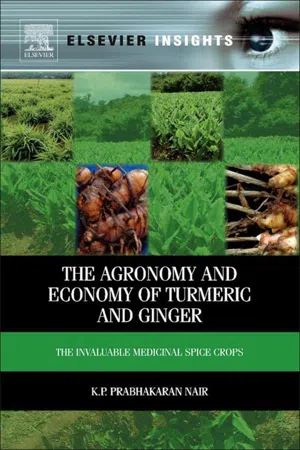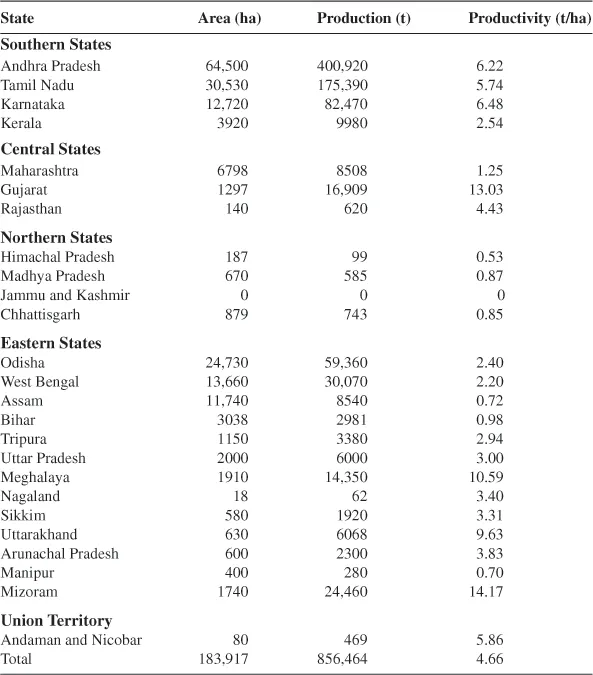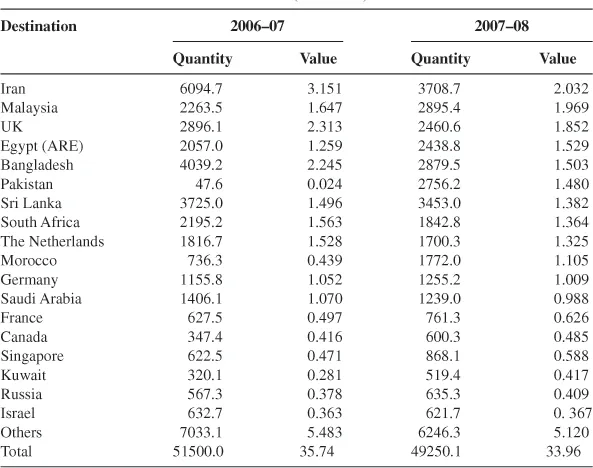![]()
1
Turmeric
Origin and History
When one leafs through ancient scripture, primarily Indian, the most important plant that one comes across is turmeric. Turmeric, also known as “Indian saffron” has been in use dating back to 4000 BC. It is mentioned in Ayurveda, the age-old Indian system of medicine, and one encounters its name and use recorded in Sanskrit, the ancient Indian language describing the ageless Vedas (ancient Indian scriptures), between 1700 and 800 BC during the period known as the Vedic age. In fact, the use of turmeric spans many purposes, as a dye, condiment, and medicine. In Sanskrit, it is referred to as “Haridara,” a word which has two parts: “Hari” and “Dara,” meaning Vishnu, also known as “Hari,” the omnipotent and omnipresent Hindu deity; and “Dara” meaning what one wears, obviously referring to the fact that Vishnu used it on his body. In India, it is put to several uses, as a coloring material, flavoring agent with digestive properties, and in fact, no Indian preparation (vegetarian or nonvegetarian) is complete without turmeric as an ingredient. The bright yellow color of the now famous Indian curry is due to turmeric. Turmeric is much revered by the Hindus, and interestingly, is given as “Prasad” (a benedictory material) in powdered form, in some temples. Obviously, whoever originated this idea had two purposes in mind—to bless the recipient and to give him or her material that has great medicinal value. Characa and Susruta, the great ancient Indian physicians who systematized the Ayurvedic system of medicine, have cataloged the various uses of turmeric (Anon, 1950; Nadkarni, 1976). Also the Greek physician Dioscorides, in the Roman Army (AD 40–90) makes a mention of turmeric. In Malaysia, a paste of turmeric is spread on the mother’s abdomen and on the umbilical cord after childbirth in the belief that it would ward off evil spirits, and also would provide some medicinal value, primarily antiseptic. Both the East and the West have held turmeric in high esteem for its medicinal properties. The Indus Valley Civilization dating back to 3300 BC in western India was involved in the spice trade, of which turmeric was an important constituent. The Greco-Roman, Egyptian, and Middle East regions were all familiar with turmeric (Raghavan, 2007).The crushed and powdered rhizome of turmeric was used extensively in Asian cookery, medicines, cosmetics, and fabric dying for more than 20,000 years (Ammon and Wahl, 1991). Early European explorers to the Asian continent introduced turmeric to the Western world in the fourteenth century (Aggarwal et al., 2007). About 40 species of the genus Curcuma are indigenous to India, which point to its Indian origin (Velayudhan et al., 1999). Apart from Curcuma longa, several species of economic importance are available, such as Curcuma aromatica Salisb., Curcuma amada Roxb., Curcuma caesia Roxb., Curcuma aeruginosa Roxb., and Curcuma zanthorrizha Roxb. About 70–110 species of the genus have been reported throughout tropical Asia. The species in India, Myanmar, and Thailand show the greatest diversity. Some species are seen as far away as China, Australia, and the South Pacific, while some other popular species are cultivated all over the tropics.
Turmeric, originating from India, reached the coast of China in AD 700 and reached East Africa 100 years later and West Africa 500 years later. Arab traders were instrumental in spreading the plant to the European continent in the thirteenth century. There is a parallel here between black pepper and turmeric. The first explorers who went out in search of both spices were Arabs, and in fact the sea route was a secret until the Europeans came on to the scene, as exemplified by the landing of Vasco da Gama in coastal Malabar in Kappad, in Kozhikode district in Kerala State, India. The exact location in India where turmeric originated is still in dispute, but all the available details point to its origin in western and southern India. Turmeric has been in use in India for more than 5000 years now. Marco Polo described it in AD 1280 in his travel memoirs about China. During his several legendary voyages to India via the “Silk Route,” Marco Polo was so impressed by turmeric that he had mentioned it as a vegetable which possesses properties akin to saffron but is not actually saffron (Parry, 1969). Probably that is also the reason why it was then known as “Indian saffron.”
Turmeric derives its name from the Latin word “terra merita,” meaning meritorious earth, which refers to the color of ground turmeric, resembling a mineral pigment. The botanical name is Curcuma domestica Val. Syn. Curcuma longa L. belongs to the family Zingiberaceae. The Latin name for turmeric is Curcuma longa, which has its origin in the Arabic name “Kurkum,” for this plant (Willamson, 2002). In Sanskrit, it is called “Haridara” (“The Yellow One”), “Gauri” (“The one whose face is light and shining”), “Kanchani” (“Golden Goddess”), and “Aushadi” (“Herb”). “Haridara” also comes from the Mundas, a pre-Aryan population, who lived through much of their life in northern India (Frawley and Lad, 1993). The ancient Indian Vedas also refer to a set of people called Nishadas, literally translated as “Turmeric Eaters.” Turmeric has also been used as a dye for mustards, canned chicken broth, and pickles. It has been coded as food additive “E 100” in canned beverages, baked products, dairy, ice cream, yogurts, yellow cakes, biscuits, popcorn, sweets, cake icing, cereal, sauces, gelatin, and also direct compression tablets.
Because of its unique color and history, turmeric has a special place in both Hindu and Buddhist religious ceremonies. Initially, it was cultivated as a dye because of its brilliant yellow color. With the passage of time, ancient populations came to know of its varied uses and they began introducing it into cosmetics. The plant’s roots are used in one of the most popular Indian Ayurvedic preparations called “Dashamularishta,” a concoction prepared from 10 different types of roots, which relieve fatigue, and have been in use since thousands of years. The plant’s flowers are used as an antidote against worms in the stomach of humans and can also cure jaundice and venereal diseases, and have been known to have specific properties to combat mental disorders. Human breast tumors can be treated with turmeric leaf extracts.
Area and Production
About 80% of world turmeric production is from India. India is the largest producer, consumer, and exporter. The plant grows extensively in the country, but the southern states of Tamil Nadu and Andhra Pradesh, Maharashtra in central, and West Bengal in east India respectively grow it extensively (Spices Board, 2007). Overseas producers are Thailand, China, Taiwan, South America, and the Pacific islands. Major importers are Japan, the United States, the United Kingdom, Sri Lanka, North African countries and Ethiopia in East Africa, and Middle Eastern countries. Iran is the largest importer. China produces about 8%, followed by Myanmar (4%), while Nigeria and Bangladesh combined contribute 6% of world production. Recent statistical estimates indicate Indian production at 856,464 metric tons from a total acreage of 183,917 hectares (Spices Board). In 2006–07, India exported 51,500 metric tons valued at US$35.77 million. In 2007–2008, world export totaled 49,250 metric tons valued at US$33.87 million, and in the following year, the corresponding figures were 52,500 metric tons valued at US$35.77 million. From India’s total export, 65% is exported to the United Arab Emirates (UAE), the United States, Japan, Sri Lanka, the United Kingdom, and Malaysia. The institutional sector in the West buys ground turmeric and oleoresins, while dry turmeric is preferred by the industrial sector. Table 1.1 gives the details about the turmeric scenario in India.
Table 1.1
Turmeric Area, Production, and Productivity in Indian States
Source: Spices Board, Kerala State, India.
In India, turmeric is produced in 230 districts in 22 states (Table 1.1). Andhra Pradesh, Tamil Nadu, Odisha, Karnataka, and West Bengal are the major turmeric-producing states which contribute 90% of the production in the country. Turmeric is available in two seasons in India (February–May and August–October). The different varieties of turmeric traded in India are Alleppey Finger, from the State of Kerala; Erode Turmeric and Salem Turmeric, both from the State of Tamil Nadu; Rajapore Turmeric and Sangli Turmeric from the State of Maharashtra; and Nizamabad Bulb from the State of Andhra Pradesh. The major turmeric trading centers in India are Nizamabad and Dugirala in Andhra Pradesh; Sangli in Maharashtra; and Salem, Erode, Dharmapuri, and Coimbatore in Tamil Nadu.
Global Turmeric Scenario
The global turmeric production is around 1,100,000 tons per annum. India’s position in global turmeric trade is formidable, with a total of 48% in volume and 44% in value. Table 1.2 gives a country-wise breakdown.
Table 1.2
Export of Turmeric from India Around the World in US$ (million)
Source: Spices, Kerala State, India.
India is the global leader in turmeric export and its value-added products. The UAE is the major importer of turmeric from India, and it accounts for about 18% of the total export volume. The UAE is followed by the United States with 8%. The other leading importers are Bangladesh, Pakistan, Sri Lanka, Japan, Egypt, the United Kingdom, Malaysia, South Africa, the Netherlands, and Saudi Arabia. These countries together account for 75% of the total import volume. Asian countries are the main suppliers of turmeric with India leading the pack. The remaining 25% of the total global import volume is met by Europe, North America, and Central and Latin American countries. The United States imports 97% of its turmeric requirement from India and the remaining 3% from the islands of the Pacific and Thailand. Of the total global production, the UAE accounts for 18% of the imports, followed by the United States (11%), Japan (9%), Sri Lanka, the United Kingdom, and Malaysia put together 17%.
References
1. Aggarwal BB, Sundaram C, Malani N, Ichikawa H. Curcumin: the Indian solid gold. Adv Exp Med Biol. 2007;(595):1–75.
2. Ammon HPT, Wahl MA. Pharmacology of Curcuma longa. Planta Med. 1991;57:1–7.
3. Anon. Curcuma in. “The Wealth of India”, Raw Materials New Delhi: Publications and Information Directorate, CSIR; 1950; 11.
4. Frawley D, Lad Vasant. The Yoga of Herbs New Delhi: Lotus Light Publications; 1993.
5. Nadkarni KM. In: Nadkarni AK, ed. Indian Matera Medica. Bombay: Popular Prakashan Publications; 1976.
6. Parry JW. Spices Vol I The Story of Spices and Spices Described Vol II Morphology, Histology and Chemistry New York, NY: Chemical Publishing; 1969.
7. Raghavan, S. (Ed.), 2007. Handbook of Spices, Seasonings and Flavourings. (ISBN O-8493–2842-X).
8. Spices Board, 2007. <http://www.indianspices.com/>.
9. Velayudhan KC, Muralidharan VK, Amalraj VA, Gautam PL, Man...



